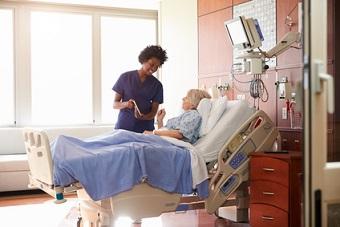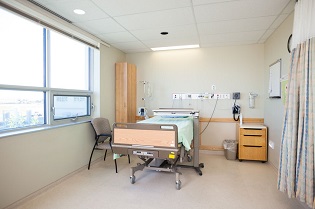Support Surfaces Do Not Replace the Need for Good Pressure Ulcer Care
September 27, 2018
Part 1 in a two-part series looking at the basics of correctly using support surfaces to help redistribute pressure. Read Part 2 here.
On occasion there are Administrators or a Director of Nursing who are amazed (not surprised) that despite their use of pressure-“relieving” mattresses and chair cushions, their facility is still experiencing in-house acquired pressure ulcers. Of course, a teaching moment presents itself, and the lesson begins. The items referred to are going to “redistribute” pressure, not relieve it, so there is either a lack of understanding or a misuse of terminology, and clarification is necessary.
Purpose and Function of Support Surfaces
Support surfaces alone neither prevent nor heal pressure ulcers. They are to be used as part of a total program of prevention and treatment. When pressure ulcers deteriorate or fail to heal, the professional should consider replacing the existing support surface with one that will improve pressure redistribution and microclimate (heat and moisture control) for the individual. Changing the support surface is only one of several strategies to consider. The individual and his or her pressure ulcer should be re-evaluated. Preventive interventions and local wound care should also be intensified as needed. A significant increase in risk status may also prompt such re-evaluation of the individual and the support surface.
Support surfaces as a general recommendation provide a support that is properly matched to the individual’s needs for pressure redistribution, shear reduction, and microclimate control and would replace the existing mattress for the individual if she or he: cannot be positioned off the ulcer; has pressure ulcers on two or more turning surfaces (e.g., the sacrum and trochanter); has limited turning options; fails to heal or demonstrates ulcer deterioration despite appropriate comprehensive care; is at high risk for additional ulcers; and “bottoms out” on the existing support surface.
Replacement and Re-Evaluation of Support Surfaces
If pressure ulcers are not healing or you find individuals are sustaining in-house acquired breakdown: re-evaluate the individual and his or her pressure ulcer(s); intensify prevention strategies as indicated; and then consider changing the support surface to improve pressure redistribution, shear reduction, and microclimate control matched to the individual’s needs. Before replacing the existing mattress, evaluate the effectiveness of previous and current prevention and treatment plans. Set treatment goals consistent with the individual’s goals, values, and lifestyle. Then, and only then, select a support surface that meets the individual’s needs. Considering the following: the number, severity, and location of the pressure ulcer(s); the patient’s risk for additional pressure ulcers; and the need for additional features, such as ability to control moisture, temperature, and friction or shear.
Once you have selected the new support surface, evaluate the appropriateness and functionality of the support surfaces on every encounter. This means a level of training for all caregivers and some education for family and significant others about functions and repositioning. Your evaluation must include verification that the support surface is still functioning to its original intended specifications before using it for an individual with an existing pressure ulcer, as well as identification of any preventable potential complications of support surface use. This doesn’t mean you picked the wrong device; it may simply mean things have changed since the device was selected. Whether that happens or not, be prepared.
Limit the amount of positioning devices and incontinence pads that are compatible with the support surface because these often create pressure points that have a tendency to lead to new trauma areas on the delicate tissues of our older patients.
Positioning and Repositioning
Definitely continue to turn and reposition the individual regardless of the support surface in use. Establish turning frequency based on the individual’s response and characteristics of the support surface. Make sure the direct caregivers are aware not to position an individual directly on a pressure ulcer. There are ways of positioning to a side with an injury by utilizing pillows as support and making the client comfortable without having direct pressure on the ulcer, but these techniques require education and demonstration. Take the time to do both.
Inspect the skin for additional damage each time the individual is turned or repositioned while in bed. Do not turn the individual onto a body surface that is damaged or still reddened from a previous episode of pressure loading, especially if the area of redness does not blanch (i.e., stage 1 pressure ulcer). Limit head-of-bed elevation to 30 degrees for an individual on bedrest, unless contraindicated by a medical condition. Encourage individuals to sleep in a 30- to 40-degree side-lying position or flat in bed if not contraindicated. If possible, get maintenance to indicate on the bed what 30 degrees is as a visual reference. Use transfer aids to reduce friction and shear. Lift—don’t drag—the individual while repositioning. This is a pet peeve of mine; they are called lift sheets, not drag sheets. It takes two people. Don’t do this alone! Do not leave moving and handling equipment under the individual after use, another problem I often see. Because activity is so important to the nutrition and integrity of the skin, increase activity as rapidly as is tolerated. Do not leave the individual on a bedpan longer than necessary. Do not use ring- or donut-shaped devices. Do not apply heating devices (e.g., hot water bottles, heating pads, built-in bed warmers) directly on pressure ulcers or areas of non-blanching tissue. Heat increases the metabolic rate, induces sweating, and decreases the tolerance of the tissue for pressure. When the body heat cannot dissipate, it will increase the risk of skin maceration and may impede healing.
Stage 1 and 2 Pressure Ulcers
Consider higher-specification foam or similar non-powered pressure redistribution support surfaces for category or stage 1 and 2 pressure ulcers while the patient is in bed and avoid prolonged head-of-bed elevation that can cause a slouched position that places pressure and shear on the sacrum and coccyx. Also use a pressure-redistribution cushion in the chair for individuals with stage 1 or 2 pressure ulcers, but minimize seating time to three times a day in periods of 60 minutes or less, and consult a seating specialist if pressure ulcers worsen on the seating surface selected. Evaluate the sitting position to ensure that the feet are properly supported directly on the floor, on a footstool, or on footrests when sitting (upright) in a bedside chair or wheelchair for proper weight distribution. It would be wise to avoid seating an individual with an ischial ulcer in a fully erect posture (in chair or bed). With all ulcers or individuals prone to redness or breakdown, modify sitting-time schedules and re-evaluate the seating surface and the individual’s posture if the ulcer worsens or fails to improve.
Stage 1 and 2 Pressure Ulcers of the Heel
Relieve pressure under the heel(s) with category or stage 1 or 2 pressure ulcers by placing legs on a pillow to “float the heels” off the bed or by using pressure-reducing devices with heel suspension. That means nothing is touching the heels—it doesn’t matter how soft the pillow is, if the heels are resting on it there is pressure being exerted on the heel. The heels need to be suspended!
Stage 3, 4, and Unstageable Pressure Ulcers and Deep Tissue Injury
Position the individual off of the area(s) of suspected deep tissue injury with intact skin. If pressure over the area cannot be relieved by repositioning, evaluate the individual and provide a support surface properly matched to his or her needs while considering pressure redistribution, shear reduction, and microclimate control. Just plain keep the individual off of the area as much as possible.
Stage 3, 4, and Unstageable Pressure Ulcers of the Heel
Place the leg in a device that elevates the heel from the surface of the bed, completely offloading the pressure ulcer, applied according to the manufacturer’s instructions. Ensure that the device is not too tight and does not create additional pressure damage. Check device placement more frequently in individuals with neuropathy, peripheral arterial disease, or lower extremity edema or those who are likely to develop edema. Remove the device periodically to assess skin integrity.
About the Author
Susan M. Cleveland, BSN, RN, WCC, CDP, NADONA Board Secretary, is Wound Care Certified through National Association of Wound Care since 2004. Currently, she consults in LTC and alternate care settings on wounds, skin care, and various other issues. She has been employed in the long-term care setting since 1969, spending 25 years in a long-term care rehabilitation facility where the focus was wound healing therapies.
NADONA/LTC has been a leading advocate and educational organization for DONs, ADONs, and nurses in long-term care since 1986. With 40 state chapters, it continues to be the largest organization representing nurses working in both post-acute and long-term care settings. NADONA/LTC offers a wide array of services to its members, including educational materials; conferences; executive fellows program, webinars, scholarships; Nurse Leader, Licensed Practical Nurse and Assisted Living certification programs; a mentoring program; and a quarterly journal, The Director. Through its publications and programs, NADONA/LTC reaches approximately 20,000 nurses who are employed in long-term care. For more information regarding NADONA/LTC, please contact their offices at 800-222-0539 or visit their website at https://www.nadona.org.
The views and opinions expressed in this content are solely those of the contributor, and do not represent the views of WoundSource, HMP Global, its affiliates, or subsidiary companies.










